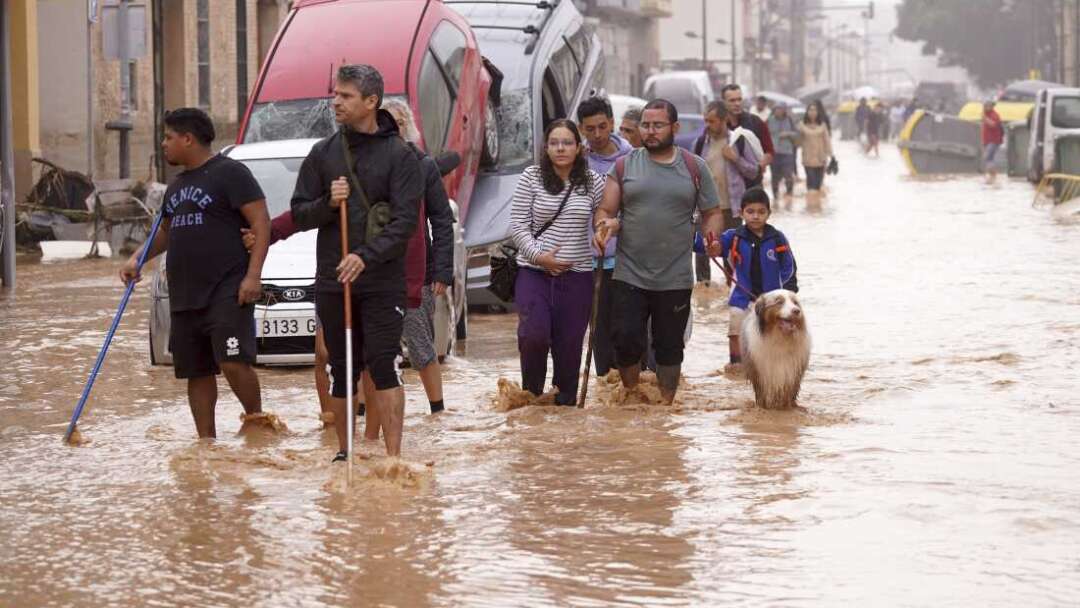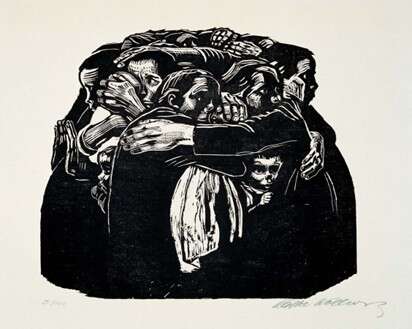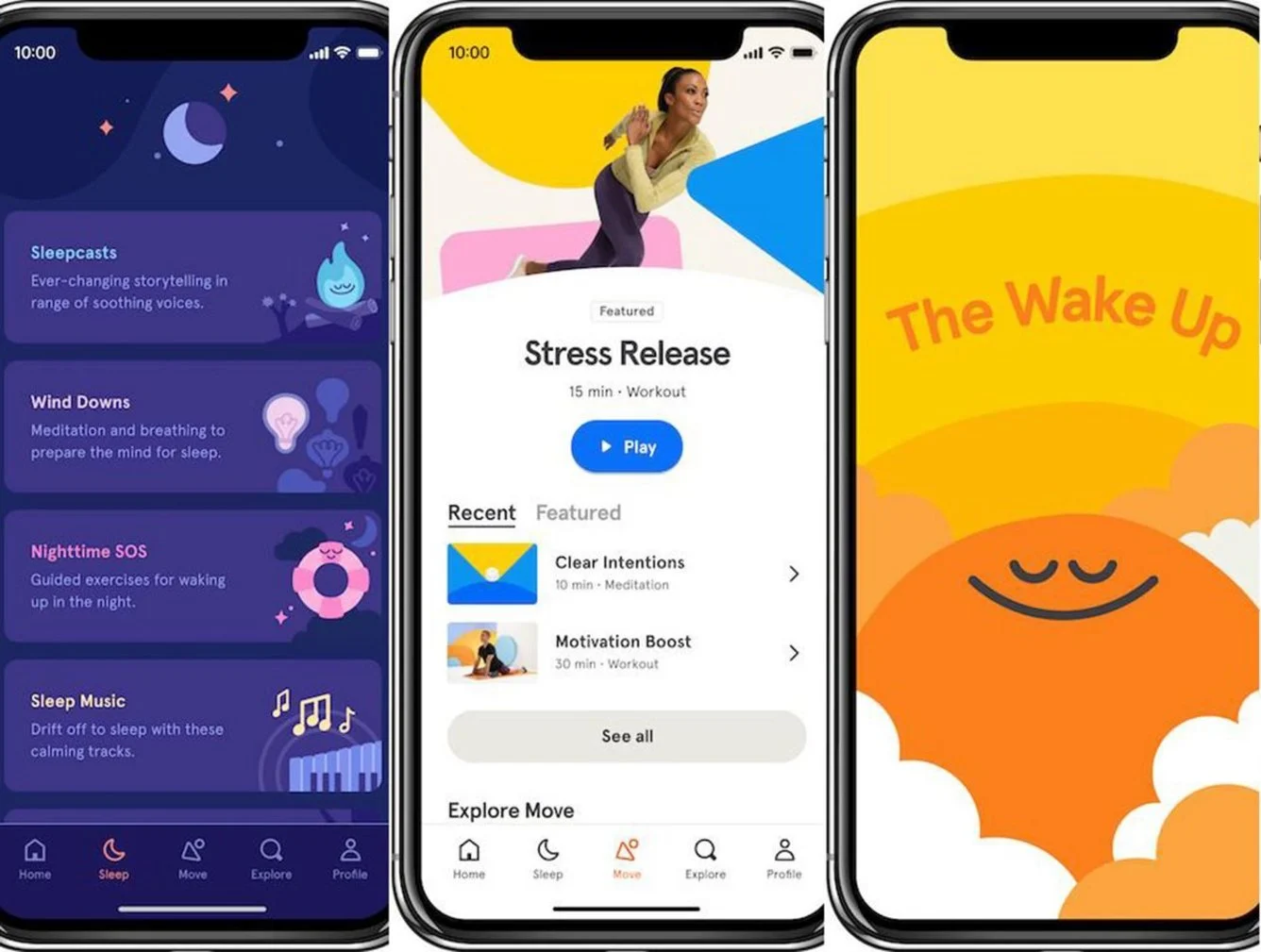Natural disaster and civic literacy— Language acquisition in the wake of DANA

Late October of 2024, DANA (Depresión Aislada en Niveles Altos, ‘Isolated Upper-Level Depression’) left substantial wreckage to Southern Spanish infrastructure and human life. DANA is the Spanish term for a weather system that results from a mixing of existing cold air in a region with travelling disruptive warmer winds, which results in inclement and at times devastating weather systems in isolated regions causing flash floods, landslides, and over time soil erosion (Conesa). Increasingly common in the Mediterranean basin, its newest landfall in the Valencian community of Spain caused overwhelming tragedy among small towns and damage to trust in local and national governing systems.
Civic literacy and climate crisis go hand in hand. Without a civically literate population, negative trends in climate crisis are primed to intensify. In this essay, I would like to interrogate the role of foreign educators, as outsiders coming into a culture. What is the role of acquiring second languages in times of crisis? I aim to discuss how the learning of a foreign language by a foreign teacher is a complicated but hopeful aid for youth in improving their civic literacy which can in turn aid them in attending to looming matters of environmental and political action.
In the school year preceding this event I came to the Valencian community as an Auxiliar de Conversación de ingles (English language assistant), working in a high school and vocational training school in the town of Xàtiva, an in-land town of 30 000. During my year in the region, I could not help but comment on the sunny weather I was seeing year-round, coming from Canada where I had only ever experienced severe winters and humid summers. The students and teachers I worked alongside were not as ecstatic as I was in the experience of a warm winter and virtually rainless spring. They expressed concern, knowing that this was not their norm, and that their region was increasingly prone to DANA events. The year passed and I taught English through the lens of cultural sharing, inviting students to peer into the lives, traditions, and foods of Canada.
I left Spain before the DANA system made its way through Valencia. I know that my experience of Spain is abnormal and that I cannot wholly grasp the weight of the situation nor the rhetoric which surrounds it. This is in part due to the language barrier, with locals speaking Spanish and Valencian, and myself speaking English and limited Spanish. It is also partly due to my physical distance from Spain; what news networks convey about disasters abroad tend to utterly negate the felt reality. I only learned of these realities through the teachers and connections I made personally whilst there. In the autumn of this year, I will return as a language assistant to the same small town. With the events that have passed, how might my position as a foreign language assistant engage students in a newfound civic literacy?
Kathleen Gallagher, a University of Toronto based researcher and professor, has compiled comprehensive global studies over the years on theatre as a powerful medium of expression for youth. Within Global Youth Citizenry and Radical Hope, Gallagher emphasizes the ‘Global Youth Citizenry,’ asking what change comes to youth when we view them as citizenry and what it means for ‘citizens,’ a word that signifies the separation of states and an ideology of inside and outside to relate to the ‘global’ (2).
Around the world, youth are increasingly aware of the consequences of decision-making made by their leaders. Youth are similarly increasingly prone to facing ‘once in a lifetime’ environmental disasters multiple times throughout their lives, altering their view on what is normal. In a culture where youth are asked to adjust to the global climate and adjust to the powers held over them, it is our responsibility as teachers and adults to aid and guide our youth towards a hopeful future that belongs to them. Gallagher’s research is highly aware of the unilateral relationship between adults and youth; consequently it “asked of [them], the adults in the room, researchers, teachers, artists, parents, social workers or theatre directors, socially located as [they] were, to turn towards youth in [their] design, in [their] methods, in [their] desires, in [their] knowledge production: to adjust” (15). The framing of adjusting oneself for the youth we encounter is crucial for the foreign language assistant. Contractually we are not to speak in Spanish or Valencian within the classroom, but there are other ways we can adjust to the changing needs of our students. Gallagher emphasizes the form of theatre as a tool for expression, and because my core task as an assistant is to engage and entice students to converse with myself using the language, theatre as a collaborative practice becomes especially apt.
Language acquisition in these towns is a politically charged undertaking. Under the fascist governance of Francisco Franco, local languages of Catalan, Basque, and Valencian were suppressed and criminalized (Bowman). Cameron Bowman, also a language assistant having worked in Valencia reflects that historically, “[c]riminalisation meant there was no official documentation in Valencian, publication in Valencian was banned, and children were not educated in the language.” For many students in high school today, their parents or grandparents could not learn Valencian publicly in schools as they do now. As a foreign language assistant, it is crucial to remain cognizant of bringing a language into communities coming back from having their languages suppressed, and I must remain cognizant to not promote a suppression of their languages via a promotion of English.
A framing question to Gallagher’s study asks “how, when, and under what conditions [do] young people invest in their learning and their civic commitments[?]” (3). Their team uses the ‘theatre of the real’ (8) to demonstrate the importance of real life in relation to students’ school lives. Drawing from Carol Martin’s Theatre of the Real, Gallagher hoped to “recycle reality” into performance. Theatre can successfully recycle reality when it uses real words, real stories, and real events to frame its performances (8). When students of Gallagher’s study performed these events, “it was often in the selection, interpretation, and fictionalization of figments from real life that the young people effectively communicated their reality.” (9). The important work of theatre is that it leaves space for interpretation and space for speaking without having to reveal particular circumstances of one’s life to make social commentary. The events dramatized and language used may be verbatim to a situation, but they do not necessarily have to be the students who have experienced it and this separation both allows the student to distance themselves from the performance and provide the space for their own interpretation and work upon it.
In the Radical Hope study, the team emphasized the role that misunderstandings made in understanding students’ theatrical work:
“our misunderstandings of their theatrical metaphors, their titling, their sound choices to set mood, our faltering translations, all of these things created riddles for us, stalled hasty interpretations, forced us into a simpler communication and exchange that often ironically made our thinking more complex, by virtue of being less readily available to us.” (14)
In the space of the language acquisition classroom, misunderstandings are common and expected features of the learning environment. Grammar, syntax, and pronunciation are all features of language which require extensive practice. It is all the more important for us teachers to move slowly and become attuned to the language and circumstances the students speak of when they have the chance to take up space. Often times in the classroom a student will bring up English slang that the lead teacher has no conception of. In these times, it is my job to both inform the teacher that the student may not actually be wrong but is rather drawing from knowledge learned elsewhere. Towards the students, it is important to clarify the misunderstanding and assure them that though they are right, it is similarly important to gain the language of critical thinking and reflection learned through the teachers so they can have the tools to differentiate between what is slang and what is not, what is useful in this situation and others.
In my prior term as a language assistant, I introduced my students to a year-long challenge co-opted from my own high school drama teacher Mr. H. Mr. H framed the challenge by positioning two teams to work with one another to strive towards a similar goal; he called it The Drama Olympics. In my iteration of it in the English classroom, I introduced to students The English Olympics. The challenges presented to students in these spaces were meant to encourage students to speak aloud, listen carefully, collaborate with one another, and apply their newly learned English vocabulary and structures to real life adjacent situations. Moreover, I pulled from the drama classroom and emphasized warm up and collaborative activities in favour of individual work. It was vital for these students to not merely just be together, but to prize the collaborative effort in this aspect of their school career. Though collaborative activities in physical education are far more common in the high school experience, language is a fundamentally social skill that requires another person in order for it to function; a language is nothing without another person to communicate with, be it verbally, textually, or from historical speakers to present day interpreters.
My infrequent visits to these English classrooms meant that students were reprieved slightly of banking method style education—as introduced and critiqued by Paulo Freire—and were challenged to put what they had learned to use. These workshops function as reminder to students of the importance of practical civic use of language that is not their maiden tongue, and the ways that they can get creative with the language are vast and possible. They draw on critically reflective methods that are perhaps alienated from the native English speaker because they do not actively think of the structure of their own words. In these circumstances it is vital to remind students that without their teachers teaching them the intricate rules and pronunciations of English, the games and activities I provide simply would not be possible. I recognize that it is easy to admire the foreign teacher who does not lecture like their day-to-day teachers, but we are reliant upon (and hopefully able to revise this method with continuing pressure) such lecturing so that they may apply those newly acquired skills.
These activities are opportunities for students to open up and express their realities, as well as spaces for reflection and thought about civic responsibility. The aftermath of the recent DANA system, closely felt, makes this format all the more vital as a space for communication, and for reminding us educators to adjust to our learners’ circumstances—a mode of engagement highlighted by Freire. The destruction of schools in the region, though not belonging to my students, are reflected through them. These are schools with which my students may have had sport competitions, had family or friends who attended, had teachers they had known, or simply a reminder of the ease with which normality can come crumbling down. Nonetheless, it serves as motivation and solidarity for those impacted, for those with stunted educational years through COVID-19 and then the largest and deadliest flooding of the region in their modern history (ITV News). DANA is a direct result of the ongoing climate crisis and thus facilitates hope for avoidable futures. The importance of radical hope in times like these is that it reminds students that we cannot maintain positions of neutrality, as lives are dependent upon it (Freire 53).
The view of pragmatic neoliberal thinkers, with their fatalistic attitudes that speak “[it is] sad, but nothing can be done about it. That’s the way things are” (Freire 51), have given up on a future. These thinkers should bring about in our youth citizenry an anger and frustration with the ideology of those who tell them everything is fine, when the evidence is apparent to youth and adults alike that change is possible, and that youth should be able to grow up in a world with a future where their democratic vote and democratic society are attributed the respect everyone is deserving of. “[Y]oung people are shouldering the weight of local burdens in global proportions” (Gallagher 16), they are taking on knowledge that they must peer outwards into the globe in order to make sense of their local, and in this study of the world they will come to decide what is required of us to alleviate those burdens. The two choices of Spanish youth should not be climate calamity or alt-right leadership as they face today; there is space for more.
The cause of the uncoordinated response to the weather system that was trackable and expected to be more intense than usual (Martínez; El Rastreador) is a failure on the part of Spain’s provincial and federal governments. It is a failure on part of a democratic system in place to uphold and serve its citizens. With growing climate misinformation, this can only be expected to increase. In the same autumn of 2024, hurricane Helene ravaged its way through Southeastern United States and portions of Mexico. The hurricane came just days before the DANA system built, and media demonstrated how masses of people evacuated and followed the guidance of authorities. The amount of rainfall in both places received were similar, as were damages to infrastructure in economic cost (Doermann; Doermann). Government responses, however, were far from alike. Where the United States issued a state of emergency, the Spanish government failed to detect and warn Valencians promptly, and in some cases actively downplayed the situation (Martínez). The goal is for youth to demand changes and demand a world adjusted towards them, and to have the world adjust towards engineering the infrastructure that can tolerate the destructive force of swelling weather events. The aftermath of DANA means that the floor is open for discourse pertaining to environmental change and a shift away from that which is objective and neutral. It is up to educators and adults in these learning spaces to keep this dialogue open and critical.
Henry Giroux, in “Rethinking Paulo Freire and Postcolonialism in the Age of Disposability,” argues that:
“[w]hat is often ignored in the call for objectivity and classroom free from politics are pedagogical practices that provide the conditions to get students to think critically, reflect on what knowledge is of most worth, how their identities are being shaped within particular relations of power, and learn how to hold power and assigned meanings accountable.”
To “learn how to hold power and assigned meanings accountable” stands out exceptionally when we apply this view to the high school classroom aware of potential environmental consequences and those who are in charge. One of the ways that I may encourage students of a small town to enact the hopeful actions we engage in the classroom is for myself to engage those activities outside of it.
The structure and space of a town is greatly different from the metropolitan space of Toronto from where I write. In Xàtiva, the structural community is robust, plazas and parks with seating are found around every corner, with people who make use of them. Sometimes overlooked is how infrastructure directly plays into the sociability of the public. Spanish homes are built to keep heat out; in the winter months this means that though it may be mild outdoors, the indoors will be significantly cooler. The structural quality of these homes directly forces people out of their isolated walls and into interaction with their peers, neighbours, friends, and family outdoors. The result is a resilient public who has a trust physically woven throughout their town and thus an ideological reflection of it similarly embedded throughout. For students to see myself actively participating in community events or present in communal areas is a key signifier of my presence in their lives not just to pass onto them a language via the banking system of education, but to engage students with an epistemic curiosity. They see in myself and other foreign assistants someone who is both sharing knowledge but also taking part in the community.
As Freire explicates, if I am to teach students an ethical lesson or make an ethical claim in their midst, I must also be able to supplement the authors with whom I agree and disagree with and demonstrate the process of discerning its value (5). In a language acquisition classroom this step must be significantly simplified and aided with the help of the classroom teacher; it is a thinking process vitally important to students in their emerging civic world, both in their learning of English and learning of their civic ability. My students see in me and other foreign language assistants not just a teacher but also a figure present in their community. They should be able to find in me new and critical viewpoints with which they can engage their worlds and lives.
Gayatri C. Spivak in An Aesthetic Education in the Era of Globalization writes about learning English as not solely about using it as a tool of communication but one through which culture can be disseminated. She writes, “the language remains most difficult to learn precisely for those students who would be most susceptible to such politicization” (55). Spivak’s argument is clear, learning a language, English literature, and critical theory are all politicizing features of education, and features which are available to students at differing levels. The students who would benefit the most from learning English as a critical theory tool are similarly the ones least likely to follow through or find it to be of importance. Critical theory is available to students in Spanish, but the views acquired in learning a separate language allows for an education just as romantic and aesthetic as it is critical. Spivak, following similar veins of educational reform as Gallagher, advocates for an aesthetic education, an education which prizes the Romantic Period that ran counter to the Enlightenment Age (2). The romantics valued emotion and the imagination, something which Gallagher and Spivak similarly call for. For my students, the present is no longer a clear binary of a colonial and postcolonial past. For us all, we are bound both to remnants of colonialism and a turning towards postcolonialism. To the students I work with today, I function as a colonizer. I bring with myself the English language under the Spanish Ministry of Education’s request to have it established in Spain. It is my duty not to expect that English take root in place of these students’ other languages but hope that within the dissemination of the language, they find a perspective with which to view the world. To return to Bowman, “[o]ur ability to understand a place is constrained by our ability to communicate with its people,” and to further stray back to Gallagher’s teams efforts; constraint is not to be feared and is rather a space for meaning making and civic learning.
How our global youth citizenry chooses to cope with their shifting times is of great importance. Actively preparing students for a climate crisis is only an aspect of their preparations for the future. As they prepare, maintaining belief in the value of democratic systems is similarly a vital cornerstone to education of youth in a global climate looking towards fascism. The broad aim is to create a civically literate youth, willing and attuned to act on matters that pertain to their societal wellbeing. The minute aim is to set this upcoming generation up so that they may value the intellectual and may strive to become intellectuals of their own generation in whatever medium is best suited.
Works Cited
Bowman, Cameron. “Valencian Road Signs.” Oxford Political Review, 14 August 2024, oxfordpoliticalreview.com/2024/08/14/valencian-road-signs/. Accessed 21 April 2025.
Conesa, María R. et al. “How did DANA event affect water status and thermal response of fruit crops?” EGU General Assembly Conference Abstracts. May 2023. 10.5194/egusphere-egu23-12977. Accessed 21 April 2025.
Doermann, Lindsey. “Devastating Rainfall from Hurricane Helene.” NASA Earth Observatory, earthobservatory.nasa.gov/images/153387/devastating-rainfall-from-hurricane-helene. Accessed 21 April 2025.
Doermann, Lindsey. “Valencia Floods.” NASA Earth Observatory, earthobservatory.nasa.gov /images/153533/valencia-floods. Accessed 21 April 2025.
El Rastreador. “Un experto de AEMET avisó hace cinco días del peligro que suponía esta DANA y fue ridiculizado en redes sociales.” El Diario, 30 October 2024, eldiario.es/rastreador/ experto-aemet-aviso-cinco-dias-peligro-suponia-dana-ridiculizado-redes-sociales _132_11778978.html. Accessed 21 April 2025.
Freire, Paulo. Pedagogy of Freedom: Ethics, Democracy, and Civic Courage. Rowman & Littlefield, 1998.
Gallagher, Kathleen et al. Global Youth Citizenry and Radical Hope: Enacting Community-Engaged Research through Performative Methodologies. Springer, 2020.
Giroux, Henry. “Rethinking Paulo Freire and Postcolonialism in the Age of Disposability.” CounterPunch, 6 December 2024, https://www.counterpunch.org/2024/12/06/rethinking-paulo-freire-and-postcolonialism-in-the-age-of-disposability/, Accessed 22 April 2025.
Martínez, Laura. “Qué era la Unidad Valenciana de Emergencias, el servicio de coordinación que Mazón suspendió al llegar al Gobierno” El Diario, 30 October 2024, eldiario.es/comunitat-valenciana/politica/unidad-valenciana-emergencias-servicio-coo rdinacion-mazon-suspendio-llegar-gobierno_1_11779165.html. Accessed 21 April 2025.
“Spain’s deadliest floods in decades: Death toll reaches 205 as temporary morgue opens.” ITV News, 1 November 2024, itv.com/news/2024-11-01/spain-floods-rescuers-search-for-missing-as-death-toll-hits-158. Accessed 22 April 2025.
Spivak, Gayatri Chakravorty. An Aesthetic Education in the Era of Globalization. Cambridge, Mass.: Harvard University Press, 2012.
Read more at By Joban Sihota.
Articles, Cultural Pedagogy, Education, Public EducationRelated News
News Listing

By Rosemary Kasiobi Nwadike ➚
Feminist Miseducation in the Afro-West: Examining (In)Formal Gender Indoctrinations
Articles, Education, Resistance, Social Justice
July 11, 2025

By Alexis Andrade ➚
Radical Love: A Revolutionary Force for Liberation
Articles, Cultural Pedagogy, Resistance
June 26, 2025

By Jovana Paramentic ➚
Commodifying Mental Health: Online Therapy Platforms Operating Within a Neoliberal Framework
Articles, Social Justice
June 25, 2025
